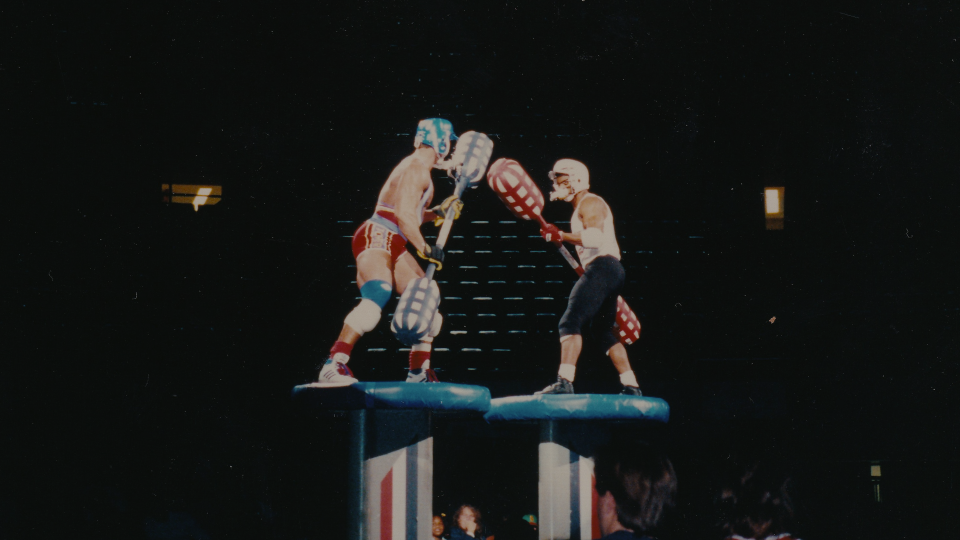Sex, drugs and steroids: 'Muscles & Mayhem' covers 'American Gladiators' pain and parties
- Oops!Something went wrong.Please try again later.
There’s no keeping “American Gladiators” down.
The muscles-and-Spandex-filled reality competition is bouncing back, more than three decades after pummeling into America's fascination as a weekly nationally syndicated battle between off-the-street amateurs and the show’s "gladiators" – ripped athletes with outsized bodies and personalities, and names like Nitro and Gemini.
Fans became hooked on regular bouts such as the Joust – in which helmeted competitors tried to knock each other off raised platforms with pugil sticks, or padded poles – for seven bruising seasons before "Gladiators" flamed out in 1996.
Following ESPN’s two-part “The American Gladiators Documentary" in May, Netflix steps up with “Muscles & Mayhem: An Unauthorized Story of American Gladiators.”
Here are the big hits in the five-part "M&M" series (now streaming):

'Gladiators' pain and injuries were as real as infamous Human Cannonball hit reveals
Skeptics who believed the competition (and battle scars) were as fake as the spray tans are dead wrong. The Gladiators, two men and two women in each episode, took their clashes with glory-seeking competitors seriously. The real injuries from dangerous challenges made for sometimes stomach-turning viewing.
The most lethal event was the Human Cannonball, which propelled contestants from an elevated platform to a rope as they sought to knock off gladiators. "It was scary as hell, everything was real. Ludicrous," says Raye Hollitt, known as Zap.
Danny Lee Clark (aka Nitro) calls the Human Cannonball "the most dangerous and worst event ever." The infamous hit on the long-haired surfer Deron McBee (Malibu) is the ultimate example of real danger. The blow sent McBee flying with such force that his knee banged into his own head. McBee gamely told the "Gladiators" audience later that he recovered by catching rays on the beach. But in reality, he suffered two broken ribs, a broken thumb, a torn bicep and a dangerous concussion. McBee, one of the original Gladiators, survived for just the first 13 episodes. And the Human Cannonball contest was retired in Season 5.
The "Gladiators" goal for eye-popping competitive spectacle ensured there would be more injuries in the seasons to come. "I knew people were going to get hurt, and they did," says Clark.
'American Gladiator' producers tried to curtail steroid use with mandatory drug tests
The popularity of "American Gladiators" exploded in the "juiced" 1990s, when anabolic steroids led to impossible physiques and doping scandals, from Major League Baseball to WWF wrestling. The colossal bodies immortalized on "Gladiators" action figures didn't come just from workouts. Former contestants discuss using everything from supplements to growth hormones and anabolic steroids.
“Everybody did steroids; that was the thing.” Sha-ri Pendleton (Blaze) says. An apparent final straw for "Gladiators" brass came when one producer found needles and syringes in a dressing room, leading to the immediate implementation of mandatory drug testing.
While the testing curtailed some usage, Clark calls it public relations damage control for the adoring public and nervous advertisers: He was given six weeks to prepare for one drug test.
"It was like, 'Wink-wink, you’re going to give us a little bit of time to get clean,'" says Clark. "It was just to tell the advertisers, 'Yes, we drug-tested the American Gladiators.'"
Still, the superstar Gladiator traveled to Mexico to buy steroids, only to be busted by border security (he also had a loaded gun in his car). A sympathetic customs officer let Clark off the hook with a ticket and tossed out the steroids.
"You wonder how far someone will go just to compete," says Clark. "For me, it was having guns pointed at the back of my head."
The national tour bus was nonstop sex, drugs and parties: 'Rock stars don't behave like that'
"American Gladiators" exploded with a 50-week national tour to 114 cities in 1991 that pitted Gladiators against the baddest contestants in each region. Gladiators were media trained to deflect journalists' questions about steroids by changing the topic to when tickets were going on sale for the eventually sold-out tour.
The constant tour-bus trips were pure debauchery, with booze, drugs, sex, groupies and wild Chippendales-style dancing contests, illustrated in the documentary with bawdy home videos that would have instantly gone viral in today's social media climate.
"I would get reports every night,” said tour manager David Fishof. “And it was crazy what was going on. (The on-site manager) said he never saw such crazy sex. They were drinking. Rock stars don’t behave like this.”
"It was the most fun I had in my entire life," says Jim Starr (Laser), who says the nonstop competition took a serious toll. "What people didn’t see is we competed every night, seven days a week. We were getting so beat."
Debbie Clark (Storm), then an aspiring Olympian, recalls a horrific competition tackle in front of a hometown Hartford, Connecticut, crowd that "snapped" her ACL tendon.
“They kicked me off the tour," Clark says. "That was how everything ended for me as a Gladiator. Not just as a gladiator, but as an athlete. My life was never the same.”
This article originally appeared on USA TODAY: American Gladiators secrets revealed in Netflix's Muscles & Mayhem

